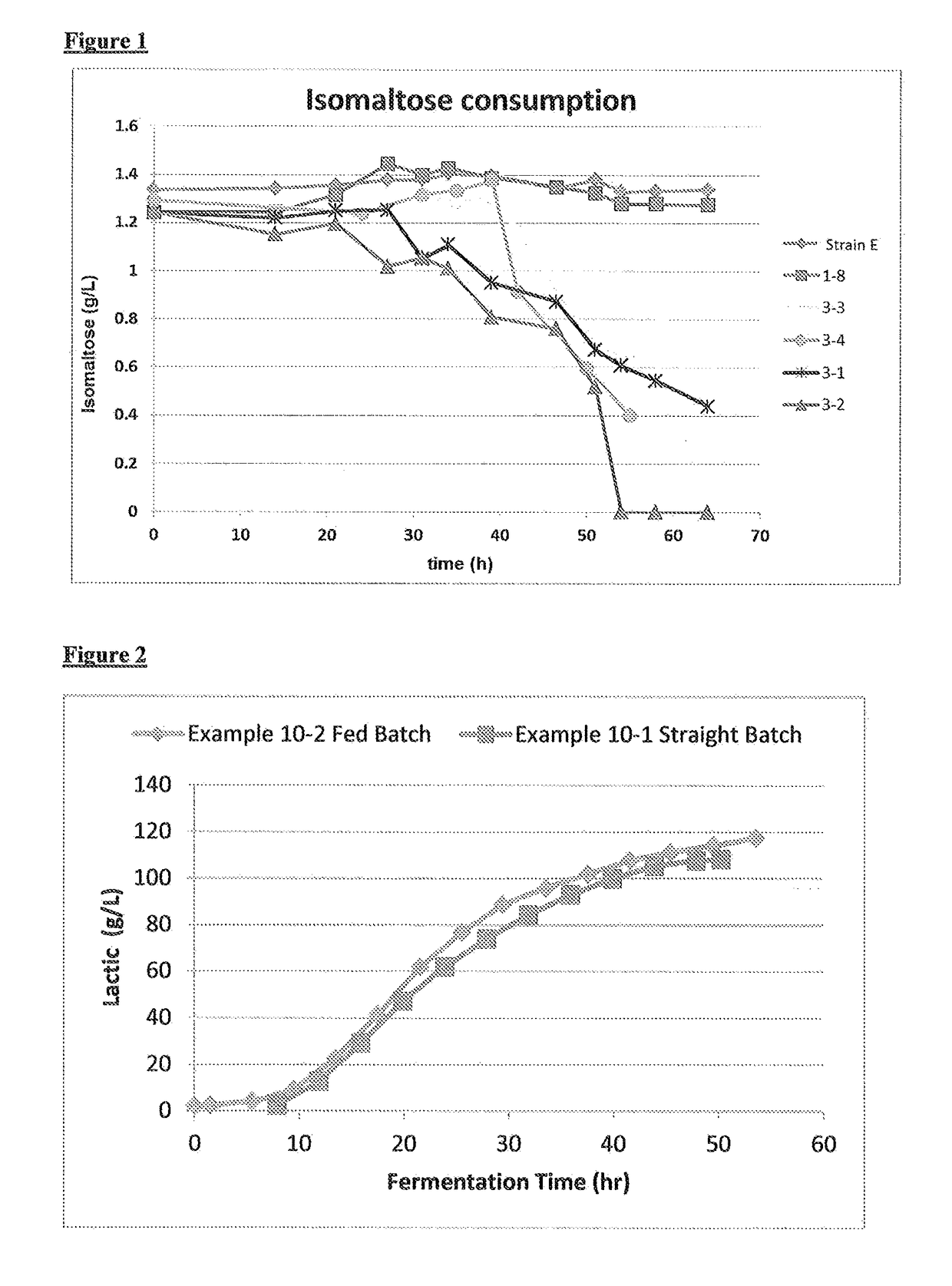Method for fermenting sugars using genetically engineered yeast
- Summary
- Abstract
- Description
- Claims
- Application Information
AI Technical Summary
Benefits of technology
Problems solved by technology
Method used
Image
Examples
example 1
n of Lactic Acid Producing Yeast Capable of Intracellular Isomaltose Consumption
Strain Strain E
[0133]An Issatchenkia orientalis host strain is generated by evolving I. orientalis strain ATCC PTA-6658 (Strain A) in a low dilution, low pH, glucose-limited chemostat with externally added lactic acid in the feed medium. Single colonies are isolated from the chemostat and screened for improved growth rate in the presence of free lactic acid. An isolate showing improvement in the screen is designated as Strain B. Both pyruvate decarboxylase (PDC) genes are simultaneously knocked out and replaced with a lactate dehydrogenase (LDH) gene from Lactobacillus helveticus to produce Strain C. Both alleles of both L-lactate:cytochrome c oxidoreductase genes (locus A and locus B, as described above) as well as both alleles of the glyceraldehyde-3-phosphate dehydrogenase gene (GPD) are deleted from Strain C to produce Strain D. Strain D is subjected to mutagenesis followed by selection on plates for...
example 2
n of Ethanol Producing Yeast Capable of Intracellular Isomaltose Consumption
Strain F
[0142]Both alleles of an L-lactate:cytochrome c oxidoreductase (locus A) are deleted from strain Strain B to produce Strain F.
Strain 2-1
[0143]Strain Strain B is transformed with SEQ ID NO: 13. SEQ ID NO: 13 contains: i) an expression cassette for the selectable marker gene melibiase from S. cerevisiae (ScMEL5); ii) an expression cassette for a maltose transporter gene from S. cerevisiae (ScMAL11), encoding the amino acid sequence SEQ ID NO: 7; and iii) flanking DNA for targeted chromosomal integration into integration locus A. Transformants are selected on YNB plates containing 2% melibiose as sole carbon source and 32 μg / ml x-alpha-gal which provides colorimetric indication of the presence of the ScMEL5 marker gene. Resulting transformants are streaked for single colony isolation on YPD containing 32 μg / ml x-alpha-gal. A single blue colony is selected. Correct integration of SEQ ID NO: 13 into the s...
example 3
of Yeast Strains with Alternative Isomaltose Transporters
Strain 3-1
[0153]Strain 1-8 is transformed with SEQ ID NO: 16. SEQ ID NO: 16 contains: i) a maltose / isomaltose transporter gene from S. cerevisiae (ScMAL11), encoding the amino acid sequence SEQ ID NO: 7; and ii) flanking DNA for targeted chromosomal integration into integration locus A. Transformants are selected on YNB plates containing 2% isomaltose as sole carbon source and 32 μg / ml x-alpha-gal which provides colorimetric indication of the absence of the ScMEL5 marker gene. Resulting transformants are streaked for single colony isolation on YPD plates containing 32 μg / ml x-alpha-gal. A single white colony is selected. Correct integration of SEQ ID NO: 16 into the selected colony is verified by PCR. A PCR verified isolate is designated Strain 3-1.
Strain 3-2
[0154]Strain 1-8 is transformed with SEQ ID NO: 17. SEQ ID NO: 17 contains: i) a maltose / isomaltose transporter gene, encoding the amino acid sequence SEQ ID NO: 18; and i...
PUM
| Property | Measurement | Unit |
|---|---|---|
| Percent by mass | aaaaa | aaaaa |
| Concentration | aaaaa | aaaaa |
| Density | aaaaa | aaaaa |
Abstract
Description
Claims
Application Information
 Login to View More
Login to View More - R&D
- Intellectual Property
- Life Sciences
- Materials
- Tech Scout
- Unparalleled Data Quality
- Higher Quality Content
- 60% Fewer Hallucinations
Browse by: Latest US Patents, China's latest patents, Technical Efficacy Thesaurus, Application Domain, Technology Topic, Popular Technical Reports.
© 2025 PatSnap. All rights reserved.Legal|Privacy policy|Modern Slavery Act Transparency Statement|Sitemap|About US| Contact US: help@patsnap.com

